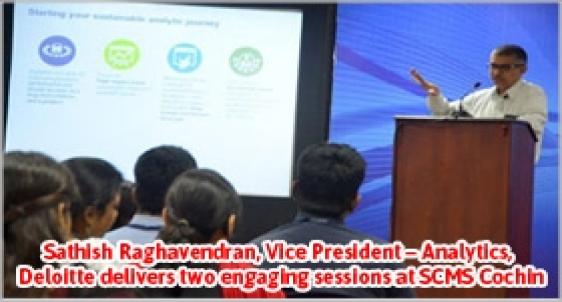
So, due to Dr. Raghavendran’s accomplishments, there was a lot to look forward to on the day he visited SCMS Cochin. The sessions lived up to the expectations as he shared his vast experience and expertise with students. He set the ball rolling by talking about innovation taxonomy. According to him, innovation should be divided into sustaining, disruptive and efficiency innovation: "The sustainable innovation problem is well understood. Customer is believable, market is predictable and traditional business methods are sufficient to survive if innovation is sustainable."
To make his point clear to the students he offered examples of disruptive innovation, including IP telephony (Skype), downloadable music (iTunes) and books (iBooks and Kindle). He reminded students that digital disruption has already happened because the world’s largest taxi company, Uber, owned no taxis, and the largest accommodation provider, Airbus, owns no real estate. “Disruptive innovation must be simplified. It comes from the bottom and not the top. Design innovation is crucial for the success of disruptive innovation,” he went on to add.
After the invigorating first session, Dr. Raghavendran moved on to the second that dealt with the significance of Analytics in addressing business challenges and data mining. He started the talk by reminding students that the start of sustainable analytics journey includes, "Identification of the problem, searching for data to solve the problem, making business proposals, identification of a solution, and selling it to the client. It is an expensive process and mixing of analytics tools in the right manner is crucial in order to be successful."
Performance gap analysis and hypothesis testing were other important aspects of Analytics that were discussed. Dr. Raghavendran also touched upon the topic of credit scoring, saying, “Credit scores help organizations decide whether to grant credit to consumers or not. There are 5 Cs to be looked at: character, capital, collateral, capacity and conditions. In Analytics, linear programming approach, logistic regression model, classification trees, neutral networks, genetic algorithms and nearest neighbors are the different approaches to be taken.”
Finally, he focused on the model development process stating various stages including: “Identifying the problem, identification of population, identification of sample, identification of variables, parameters and making forecasts. The problem statement must be clear, specific and easily understandable to avoid any kind of ambiguity.” These concluding words received a huge round of applause from the students. Dr. Raghavendran also entertained an engaging question and answer session from the gathering, which made the day’s proceedings even more significant.


























